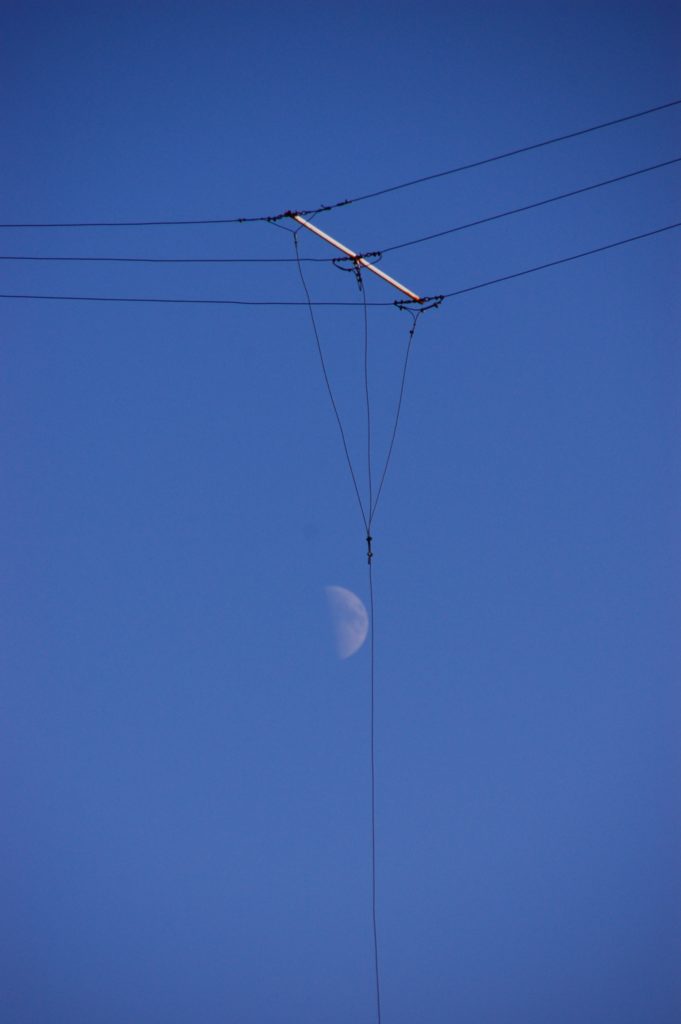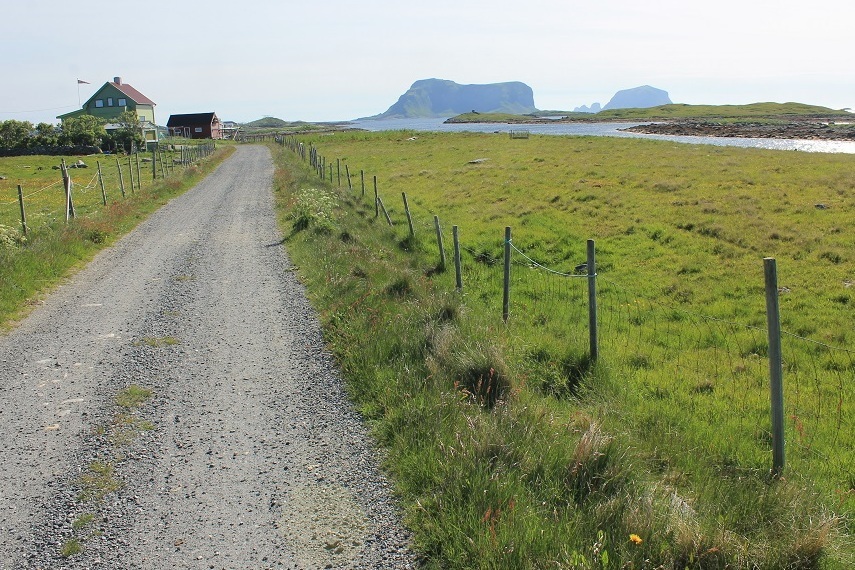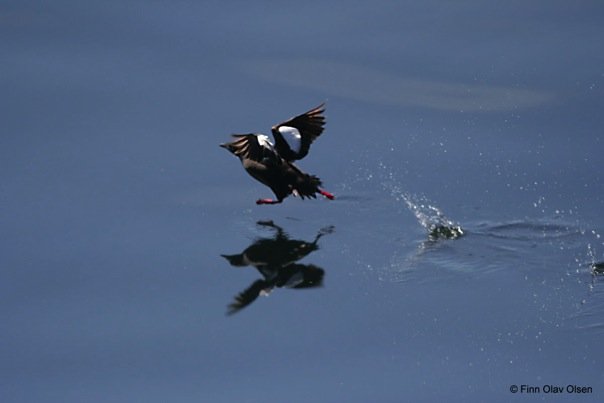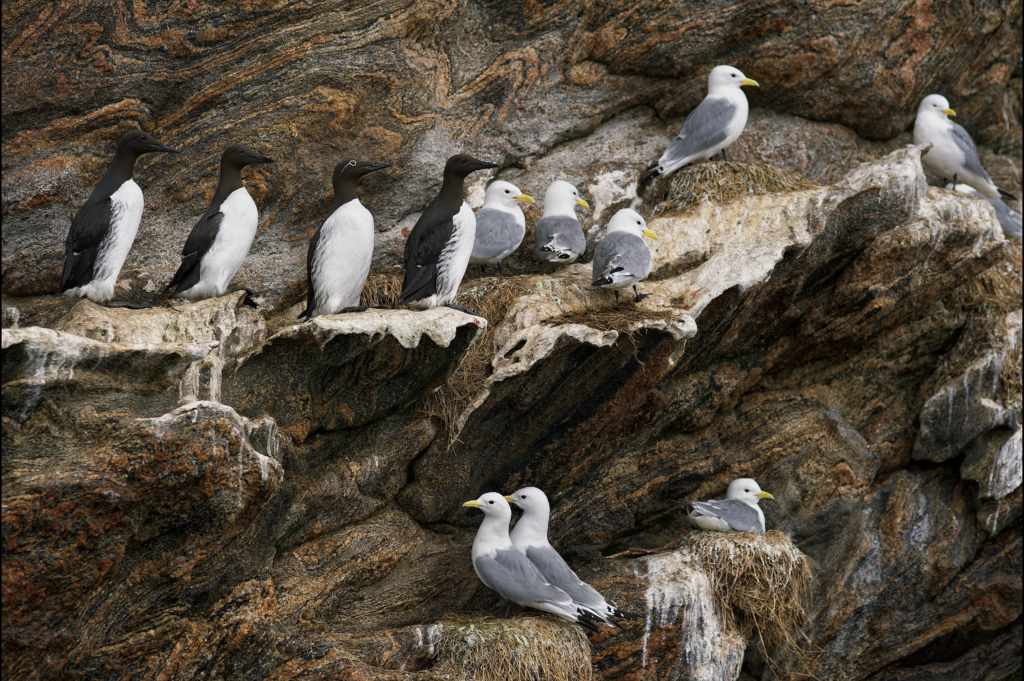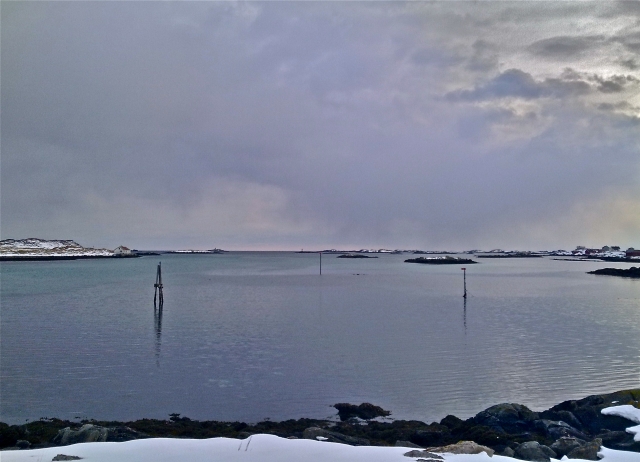The local Røst choir is a wonderful amateur choir directed by “øy-musikant” – “island-musician” Mikke Rönneberg. Due to corona, we had to cancel the heart warming Yuletide concert 2 years in a row now. As a little “plaster på såret” (plaster on the wound), I post our 2019 concert here. Some of the 2019 soloists included Hildegunn Pettersen and Chris Evjen and “toast master” was Gøran Greger.
What exactly is the Juletide bird in Nordland?
The stately red dompap, or the stylish and colorful yellow sparrow, which likes Juletide aswell?
I just as often think of another species around Juletide time. The young leave the nest around Juletide amongst this species.
The idea that right now they are sitting in their nest caves and are ready to leave the nest, in the middle of the dark-times,
is quite fantastic.
And it is happening just in these darkest of days in the Northern World, on rocky, grassy and windswept islands on the Nordland coast.
This year's Storm Petrel chicks are about to leave their nests, to move out onto the sea and fly south into the Atlantic Ocean.
Some of them fly far south of the equator, to the coast of South Africa.
What could be the reason why these breed so late in the year? The Storm Petrel is a rather small bird, it normally weighs
20-30 gramsas an adult. That is, it weighs less than a dompap, but has much longer wings. Although they are very skilled pilots
out on the open sea, they are vulnerable and completely defenseless on land. They simply cannot fly to and from the nest in daylight
without exposing themselves to the great danger of being caught by hungry seagulls and other predators. Therefore, they have to
wait to nest until the nights start to get so dark that they can fly to and from the nest without being seen.
The nest is usually located under stone slabs, inside rock piles, or in nest passages of Puffins. The Storm Petrel lays 1 egg there, it is often laid in August here in Nordland. It takes 40-50 days before it hatches, and the chick needs 56-86 days before it leave the nest, so it can be late December before they fly out! The first days after hatching, the chicks get food almost daily, but gradually it takes longer between each time. It can quickly become 4-5 days towards the end of the breeding, and then finally it can take 7 days from the last feeding until the chicks leave the nest, most likely on their own. Maybe just right now there are some young Storm Petrels sitting in nests somewhere on the coast of Nordland and waiting until a little later in the evening before they leave their safe nest for the very first time. They will instinctively seek out the open seas where they will spend most of their adult lives, only comeing ashore to nest. A Real little juletide miracle! Some fun facts:
The Storm Petrel egg weighs approx. 25% of the female birds's weight! It is in the same class with the Kiwi's egg, which is known to
have the largest egg in relation to the mother of all birds.
They always lay only 1 egg.
The egg can withstand exceptionally well to be cooled, which is crucial for them to be able to nest so far to the north so late
in the year. However, this means that it takes longer from the time the egg is laid until it hatches.
The young lay down quickly, and can weigh almost twice as much as the parent birds for a while, but then they have to slim down
considerably towards the end of the nesting period to become airworthy. See a picture of a 7-day-old cub here - it was photographed
by researchers studying the pups' ability to regulate heat.
The Storm Petrel is a numerous breeding bird in Great Britain, the Faroe Islands, Iceland and along the Norwegian/Sámi coast,
more numerous in the Mediterranean and in the Canary Islands. It is estimated that there are up to 10,000 pairs,
breedinig in Norway/Sápmi.
Although the Storm Petrel is quite small, it can become quite old. The oldest known Storm Petrel here in Norway/Sápmi,
was just over 29 years old. But a bird which was over 33 years old, has been found on the British Isles.
They begin to nest at the age of four or five.
(Complete text and photo by Atle Ivar Olsen here (BirdLife Nordland)

The northern tip of Hernyken nature reserve is looking towards the Trenyken. In between the two islands seabirds gather on the sea in large numbers. A quiet flow of sounds from thousand upon thousands of birds rafting out on the water is what this soundscape intended to capture. The birds socialize, clean their feathers, some take off and some are landing. The waves are hitting the rocky shore with resonating crevices, and various birds and insects are in the air.
Since this soundscape was recorded in 2010-2011, the decline in the seabird population on Røst has escalated. During the summer of 2020 the bird mountain of Vedøya, including the Kittiwakes breeding in the Vishellern cave, were gone.
Here is a small excerpt of a recording I did overnight at the bottom of the cave in 2010 or 2011. The sonic sensation of a flock of Kittiwakes flying out of the cave and over you is one of the strongest and most mesmerizing sound memories I carry with me.
Statistically speaking there are no more Kittiwakes and Guillemot breeding on Vedøya. In 1980 there were approximately 1.5 million pairs of Puffins breeding in all of the Røst archipelago and on Vedøya only, 12000 pairs of Guillemots and 25.000 pairs of Kittiwakes. Nowadays, the overall Puffin population is down to around 200.000 pairs and the few Guillemots left are hiding in small caves and crevices. The last Kittwakes of Røst are now clinging on in Kårøya and Gjellfruvær. If the decline continues, there will be no Puffins left in Røst by 204o.
Vedøy is the most famous of the bird mountains in the Røst arhipelago. No more than thirty years ago there were more than 20000 pairs of Kittiwakes nesting in the steep cliffs of Vedøy. The soundscape was so loud it could be heard on the neighboring islands. In late March of 2010, I experienced a vague shadow of what it must have sounded like back then when a white cloud of elegant kittiwakes vocalized and moved in and out of the bird cliffs simultaneously. Today there are only a few thousand of Kittiwake pairs left, and they are listed as critically threatened on the Norwegian red list.
Photo: Querinifest 2019 – Concert by Vishellarn – Avisa Nordland
I love how the the gak gak´s, the ho-ho -ing of The Eider and the churps of Eider chicks resonate in the narrow harbor, Keila on Skommvær.
They find shelter in the Wedge of Keila and dive to fish for scallops and small crustaceans.
In the past decades, there has been a decline in the population of Eiders all along the coast of NO/Sápmi. The
You can read more about why here:
A warmer ocean is bad news for Eiders
“The common eider is a large diving duck that can be found along the entire coast of Norway, but its numbers are decreasing. Researchers have registered declining eider populations over several years without being able to point to any specific explanation for the decline. They know that introduced American mink and birds of prey pose an increasing threat to adult eiders and that egg-predators, such as crows and large gulls, may have negative impacts on reproduction. Now, researchers have discovered that ocean warming is a direct cause of population decline in this species.” (SEAPOP)
Photo by Kåre Hansen
What does it sound like when one of Northern Europes most epic and famous bird mountains loses its voice?
To all of our discontent and shock; Vedøya (Røst) became silent in the summer of 2020,
I recently composed the first verse or episodes you could say, in a series of sound works lamenting the loss of Vedøya as a sea bird mountain.
The work wishes to speak to Vedøyas origins and life until this day, from a variety of voices.
The work’s narrative is based on a script I have been writing using many years of research into archives, my own deepening friendship with – and getting to know the island as well as conversations with local people and neighbors, bird scientists, and ornithologists who have been working on Vedøya throughout time.
I am sharing with you the newly translated script. The translation was done by the poet and writer Annabelle Despard.
////o v o////
I’m lying here resting
with my mountain sisters
the sun warms me
the winds and rain
wash
us
lichen and moss-skin
protect us
we listen to
eternity
the waves
waves
clumps of seaweed
on the shore
are stirred
by cycles
below us
we feel
the power
magma
the origin of Utrøstryggen
we are the elders
born in the world’s infancy
yet still rising
through millennia
under heavy massed ice
the ice
melting
the winds
the water
the currents
insisting
shaping and honing
landslides at times
shapes changing
new spaces made
cliff faces
are open invitations
I call them my winged. children
one springwinter they came flying
in over the hills
different voices
have
come
gone
come
gone
long gone
every spring
we are woken
and we no longer crave for company
in the long summer nights
eggs
are laid
lain on
fed
hatched
squeaking
chattering
squabbling
calling
answering
then they fly off
in August
in twilight days
It’s light tonight
but all I want is to sleep
everything is changed
I don’t know where I am
without
the screeching
the blare
the sheen of the silver mantel
a pair of ravens
are searching in vain
for life
their shrieks echo in Visheller´n
////
One springwinter long long ago
our forebirds came flying
Our time is old
it is hard to say when we came
but we remember
an ancient mineral giant
born from Utrøstryggens
300 million years
Were you expecting company?
we found rocky ledges
for white and turquoise eggs
rock nests
and hollows
such lovely song
in the steep rock face
///
I look at you
from different angles
daily
try to store
your outline
your
shape
in me
changing
with the wind
the weather
kinds of light
you are stoical today
seen from the north
I cannot see the sea
between you and Røst
you rise straight up out of the ground
a support
supporting
here we stand
glaring at each other
///
Today I came back to Vedøya
I walked up the sheep track along Bunes Bay
to the old Swiss hut for bird research
Two people
sitting on the step
tying their shoelaces
ready to investigate the auk
It is the summer of 1965
harvest
shouting and children’s laughter
sheep and lambs bleating
coffeepots rattling
a pipe is lit
But where are the kittiwakes?
///////
Nothing is as it was
we get used to the land
all over again
but everything feels strange
the choir no longer sings in unison
few or nobody
is at home
as they were
not very long ago
one auk
or a single
guillemot
dives off the cliff face
lonely arrows
vibrating in the air
In the light time
the wren sings
her solo
Birds are at home
floating weightlessly
strangely eternal
if only the sea was not so empty
birds, sheep, people, guano
plants proliferating
under the mountain’s towering
being
asleep
hunting island
gathering fodder
summer pastures
Photo by EMØV
Archival image, Vedøya, 1.6.1963 by Paul Andreas Røstad
One of the Puffin’s social activities is called wheeling. This is a cyclic group activity that happens in intervals throughout the day, the week, and the season. The Puffins move together in an elliptic circle flying against the wind up towards their particular nest sites. There will be several circles around the different parts of the colony, in several vertical layers. Part of the circle is over the seabird raft out on the waterfront and part is over the colony. I wanted to capture sounds of swarming and wheeling, both from the inside-, as well as from the outside of a skree. This is what it sounds like on a summer night in early July 2011.
What does the inside of a metal wire sound like in a storm?
I placed a pair of JFR hydraphones on one of the wires securing the mast poles into the ground of the FM antenna and what came out was rather mysterious…
This soundscape was recorded on a mild and quiet afternoon in mid-June 2011 when I was out listening to, – and looking for Guillemots towards the westside of Hernyken and the boulder skree, Johannesura. This well-known skree is adorned by 2 large rock figures created by nature. Once upon a time, it might have been a Seasámi / coastal peoples holy “seidi” rock; a place to make offerings. The stone figures have been named Johannes and Johanna (original name was Isak and ?) because they resemble an old troll couple. Also drawn by one of Norway’s most famous artists, Theodor S. Kittelsen in his publication/artist book ”Fra Lofoten – Billeder og Tekst” (From Lofoten-Images and text), published in 1891. Theodor Severin Kittelsen (1857-1914) lived on Skomvær Lighthousestaion and Røst, from the fall of 1887 to the spring of 1889 with his sister and brother-in-law, who was the lighthouse keeper’s assistant.
The Kittiwakes of Kårøya
The Olsen family has been running Kårøy rorbucamping (guesthouse) since the mid-60s. Every spring and summer season they live side by side with the Kittiwakes that breed here. Several hundred Kittiwakes have their nest sites on the buildings of Kårøya, and their sounds and sights are quite a tourist attraction. Kårøya is a key site for the monitoring of the Kittiwakes on Røst, as the biologist have easy access to nests and birds here. A stay over at Kårøya rorbucamping is heaven for a bird-lover. Lying in the soft summer grass looking at listening to the Kittiwakes is healthy for the soul, and their fascinating voices will never leave your memory.
This track also features on Soundscape Røst-Spaces and Species Vol I and was originally recorded in 2011.
About the Kittiwake – Krykkje – Vuonaskávlle
You can read more about the situations for the Kittiwakes on Røst here:
Photo by AHS
“
Jeg samler på lydlandskaper
Jeg samler på Lydlandskaper. Det er å samle på rom og atmosfærer, stemninger og emosjoner. Når man trener og utvikler lyttebevisstheten, vil det å åpne en dør inn til et annet rom etterhvert bli en sterkere fysisk opplevelse. Du hører at du går inn i et nytt rom. Det presser annerledes på trommehinnene. Hvert rom både ut og innendørs, har sin akustiske realitet og vi beveger oss inn og ut av disse akustiske virkelighetene, som også flyter over i hverandre.
Jeg forflytter meg med forskerbåten. Vi er på feltarbeid, ute blant de mange små øyene og skjærene i Røst arkipelagoen. Vi kommer til en gruppe holmer i det åpne havet, og her skal vi telle skarvereir, ærfuglreir, svartbak, gråmåke, sildemåke og teist. Også kjenner jeg med ett at lyden er helt spesiell; akkurat her og nå. Havsøye kaller lokalkjente Finn-Olav gløttet ut mot storhavet mellom Storsvarvøya og Ramnnakken/Sandøya, som er en lagune som beskytter Røstlandet mot de største bårene.
En av pionerne innenfor fieldrecordings, Bernie Krause beskriver i boka si «The Great Animal Orchestra:Finding the Origins of Music in the World’s Wild Places» hva som gjøre at den akustiske virkeligheten på et sted unikt. Stedets geografi eller rommenes arkitektur har alt og si. Geofonien: Steinenes formasjoner. Over og under vann. Botanikken. Hva slags vekster vokser her. Været. Er det sol eller regn eller snø. Blåser det? Fra hvilken retning. Havstrømmene. Er det flo eller fjære. Biofonien: Hva slags dyr og fugler har sine habitater her. Det slike lydlandskaper jeg samler på. I naturen, på landet og i byene. Noen forblir i meg som lydminner da jeg av ulike årsaker ikke får gjort opptak av dem; lydsteder på en indre ønskeliste. I ettertid husker jeg ikke hver enkelt lyd fra stedet; men bærer med meg en generell følelse av stedet; atmosfæren og stemninger i landskapet. Jeg kan beskrive “en letthet” “et lyst brus” “en åpenhet” “oppstemthet” osv. Det er alle ord som beskriver Havsøye. Steder synger til oss om vi virkelig lytter og de vil fortelle oss hva de er og hvordan de er. Men kan de rekonstrueres og omskapes? Jeg tar tak i øyeblikkenes magi; stopper tiden litt; bærer lydminnene nære hjertet for mørkere tider. Jeg bruker lydopptakene til å skape fiktive akustiske virkeligheter som igjen også kan skape mental og kroppslig romlighet i meg og i deg hvis du lytter i blinde. Jeg kan også prøve å bruke språket og beskrive lydminnene og lydstedene, slik at leseren kan skape seg et indre lydsensasjon elle lydbilde av stedet. Med språket former jeg fortellinger om lydsamling og lydlandskaper; om lytting og lyttebevisthet. Og med stemmen lytter dere til språket her og nå. Jeg møter lydlandskapene på nytt; i samklang med min egen stemme.
”Et gammelt sagn forteller om ei øy som er sunket i havet for lenge siden, som heter Utrøst eller Alvelandet. De gamle fortalte at det bare var de utvalgte som fikk se dette guddomelige landet. Stedet er ikke inntegnet på noe kart, men man skal følge skarven når den flyr ut fra Røst og vestover i Norskehavet!” (Sagnet om Utrøst)
I always long for spring. Sheep gracing, newborn lambs calling, a constant chorus of horny and hungry birds…The cooing, gak gak gak and hooing of the Common Eiders. This spring we had a very loud and joyful Willow warbler on Grimsøya.
But even this is not a spring chorus if you would compare it to 50 or 70 years back. The decline of the Common Eiders is caused by food shortage in the Ocean, marine garbage, and various disturbances.
Grimsøya is situated on the SouthWesternmost habited area on Røst. I have been so grateful and humbled to be living here in the “Margrethe house”, since 2015.
Grimsøyas etymology or “Grems-øya” as the dialect goes, indicates a very long patch of tidal zone; which describes it well.
In the old days, the Kittiwakes of Vedøya would fly in overland here towards the freshwater ponds of Øran and Ystøra. There were 500 Common Eide nests here, which the locals would look after and cater for by preparing nests each spring. The female Eider will lay up to three eggs. It is only when she has laid her third egg that she stays permanently on the nest. She will pluck the soft, insulating downs of her chest to cover the eggs. When the chicken’s hatch and the Eider have to lead all the chicks down to the seaside where they will spend most of their young and adult life, the humans on Grimsøya would kill all predator birds chasing the Eiders. And when the Eider had left the nest, the human would pick the down and begin the rather meticulous process of rinsing it. The down was used in duvets and hats and a very lucrative. product to sell. So important Røst currency.
Photo by Trond Eirik Ludvigsen
This autumn Gudrun Jørgensen passed away, 91 years old. She has been looking after Eider nests on Grimsøya for half of her life. You can read an article about her and her and other Common Eider nest protectors in the newspaper Klassekampen:
“At Røst, Jørgensen has the honorary title «eider-mother». The garden around the 88-year-old’s green house is a safe haven for the Eider pairs. Along the house walls, the nest boxes are close together, and under the stairs there is a fixed pair that nests. She can not imagine a summer without the cooing around the house. When she and her husband moved to Røst in 1950, they took over responsibility for this downpour. Since then, they have carefully arranged, given the bird’s security and picked the down for sale. Jørgensen takes her responsibility for the Eider seriously. When the nesting starts, she chases away gulls and eagles that want to forage their eggs, and unnecessary noise from summer guests is not allowed. The female Eider lies on the eggs for 21 days, and for Gudrun, the highlight of the summer comes when the mother Eider sways proudly towards the sea, followed by up to five little ones. The father stays close and follows up on the family.”
Photo by Ole Magnus Rapp for Klassekampen
Finn Olav Olsen was running Kårøya guesthouses and Seabird Safari alongside his parents Kari and Roar Olsen, in 2010. Today Finn Olav is married with 2 children, working at the airport and during the summer he runs the particularly comfy seabird safari Day at Sea. Finn Olav is also an excellent drawer and photographer.
The Kårøya buildings has since been sold in the summer of 2021. I wanted to post this interview because Finn Olav speaks of the cultural history of Kårøya and his upbringing there in the 70s. Also we discuss the decline of the seabird population and what he thinks will happen. So did his premonitions come true?
Photo by Carsten Aniksdal
Since this soundscape was recorded on the 31.3.2010, the decline in the seabird population on Røst has escalated. During the summer of 2020 the bird mountain of Vedøya became silent. Statistically speaking there are no more Kittiwakes and Guillemot breeding on Vedøya. In 1980 there were approximately 1.5 million pairs of Puffins breeding in all of the Røst archipelago and on Vedøya only, 12000 pairs of Guillemots and 25.000 pairs of Kittiwakes. Nowadays, the overall Puffin population is down to around 200.000 pairs and the few Guillemots left are hiding in small caves and crevices. The last Kittwakes of Røst are now clinging on in Kårøya and Gjellfruvær. If the decline continues, there will be no Puffins left in Røst by 204o.
Vedøya bird moutain (2010) (Track nr 4 on the album Soundscape Røst – Spaces and Species Vol I)
Vedøy is the most famous of the bird mountains on Røst. No more than thirty years ago there was more than 20000 pairs of Kittiwakes nesting in the steep cliffs of Vedøy. The soundscape was so loud it could be heard on the neighboring islands. In late March of 2010, I experienced a vague shadow of what it must have sounded like back then when a white cloud of elegant kittiwakes vocalised and moved in and out of the bird cliffs simultaneously. Today there are only a few thousands of Kittiwake pairs left, and they are listed as critically threatened on the Norwegian red list.
I was testing my new Telinga mic and It was rather late at night. I was placing some microphones in the Eastern Storfjellet skree. Just heading back to the cabin, the Puffins were murmuring all around me. It was one of those slightly mirky nights where the Puffins love being active; after midnight, and a bit rain.
I decided to put the Telinga parabol microphone down towards the rocks around me, and it resulted in a real strangely detailed recording.
The vocabulary of the Puffin vocalization is much more complex than what is described in my bird books.
I think that is something to keep in mind in general. Each creature on earth is much more complex than what a book can manage to speak to <3
Black Guillemots, Common Eiders, Eurasian Oystercatcher, Herring Gulls, Blacked Back Gulls and Wrens vocalizing in the nightfall of rain, outside NINAs research station at Hernyken nature reserve, July 2011.
Excerpt from the fieldwork diary at Hernyken Nature reserve, Røst, Juni 2011:
Working as a field assistant for Tycho Anker-Nilssen
The Sun is shining again
We have an abundance of rain water
We’re going to Røst-landet
Not the mainland
We do not have onshore winds
We live on an small island
We tie knots and weigh eggs
We walk new counts and we photograph an orchid
2 eggs
1 egg
empty nest
Early marsh-orchid
Common Eider eggs
Puffin eggs are almost white
Kittiwakes eggs are shaded
The Black Guillemot goes ashore at the high tide
The Shags are forming a black moving band on the Røst Sea
The fishermen at the Joker Røst store have strong arms and worn faces
Utdrag fra feltdagbok, Hernyken, Røst, Juni 2011:
Sola skinner igjen
Vi har masse regnvann
Vi drar til Røst-landet
Ikke fastlandet
Vi har ikke pålandsvind
Vi bor på en øy
Vi knyter knuter og veier egg
Vi går nye tellinger og vi fotograferer en orkide
2 egg
1 egg
empty nest.
Engmarihand
Ærfuglegg.
Lundefugl egg er nesten hvite.
Krykkje egg er sjatterte.
Teisten går på land med høyvannet
Skarvene danner et svart bevegelig bånd utpå Røst havet
Fiskerne på Joker Røst butikken, har sterke armer og slitte fjes
My first field recording trip to Røst took place in the early spring of 2010. I took the car ferry from Moskenes in Lofoten/Lofuohta to Røst. I arrived on a late Sunday evening, the 28th of March. I was intensely looking forward to my very first recording trip, self-funded by a DJ gig Svolvær, Lofoten/Lofuohta the night before.
I stayed in a small room at the rugged Røst Havfiskecamping together with seasonal workers from Poland. They were flown in to work twelve hours or more a day at the fish landings during the annual Lofot -fisket / Lofot fisheries, which begins in February and ends around easter every year.
Southwards view towards the ferry quay and the bird mountains. You can see Vedøya. My first few days on Røst were spent walking about. The mainland of Røst is completely flat. The recordings were made with the equipment I had rented from NOTAM in Oslo. A battery-hungry Tascam recorder and a pair of wonderful Neumann omnidirectional mics.
Mainland Røst is a cluster of large and small islands, islets, and skerries and along all the shores the tide comes and goes eternally. It had been a heavy winter and snow was still covering the ground and the bird mountains. What you hear on this recording is a close-up of the shoreside below the snow, pointing down into the seaweed where the tide was slowly sipping in and out through the seaweed branches. The gulls vocalizing presume are Herring Gulls, Common Gulls, and Great Blacked Backed Gulls.

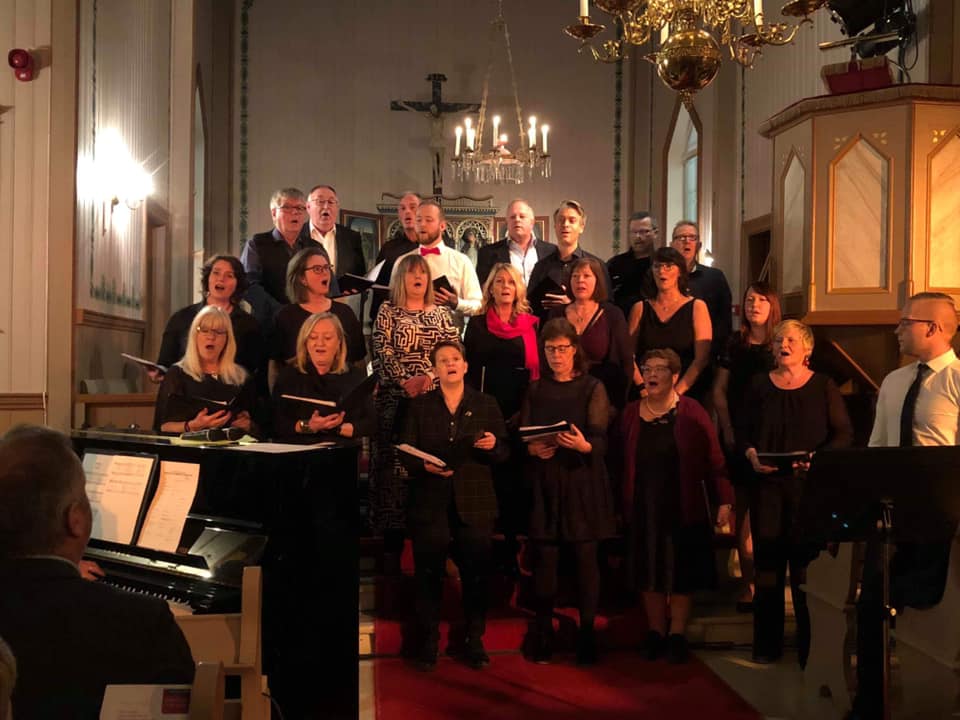



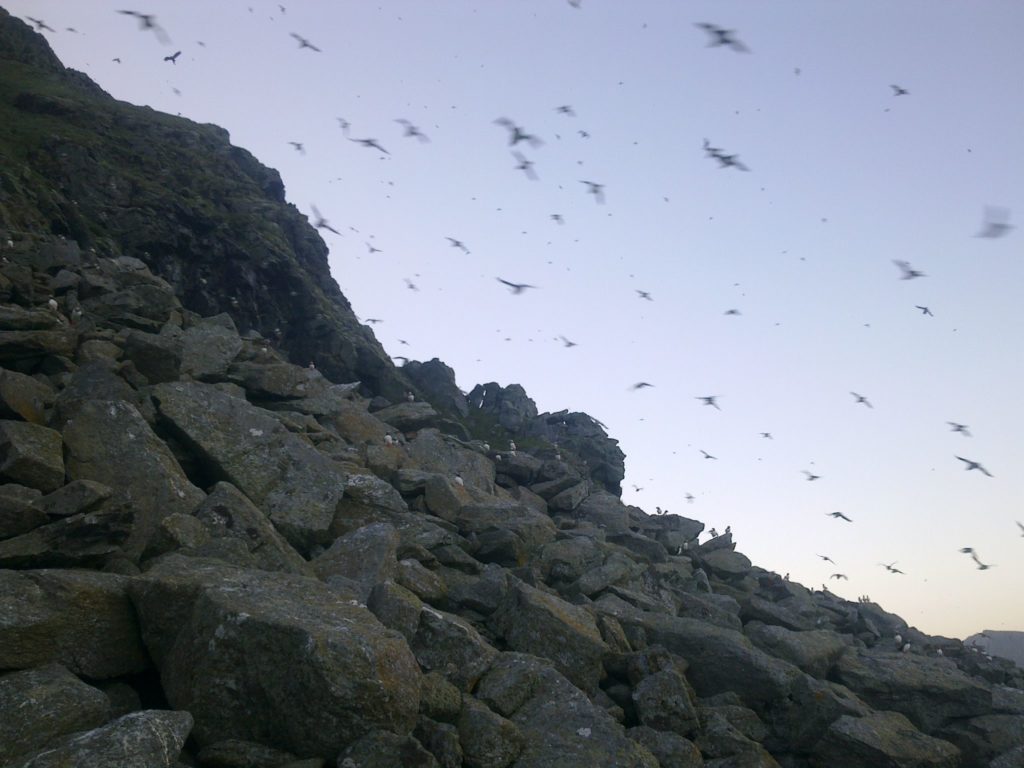
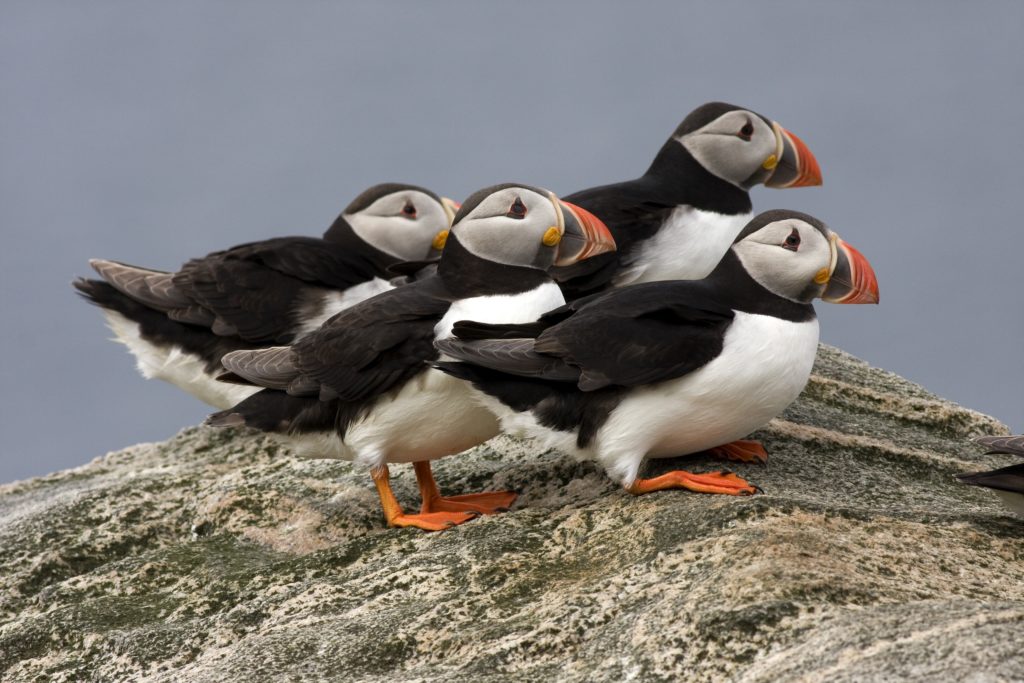

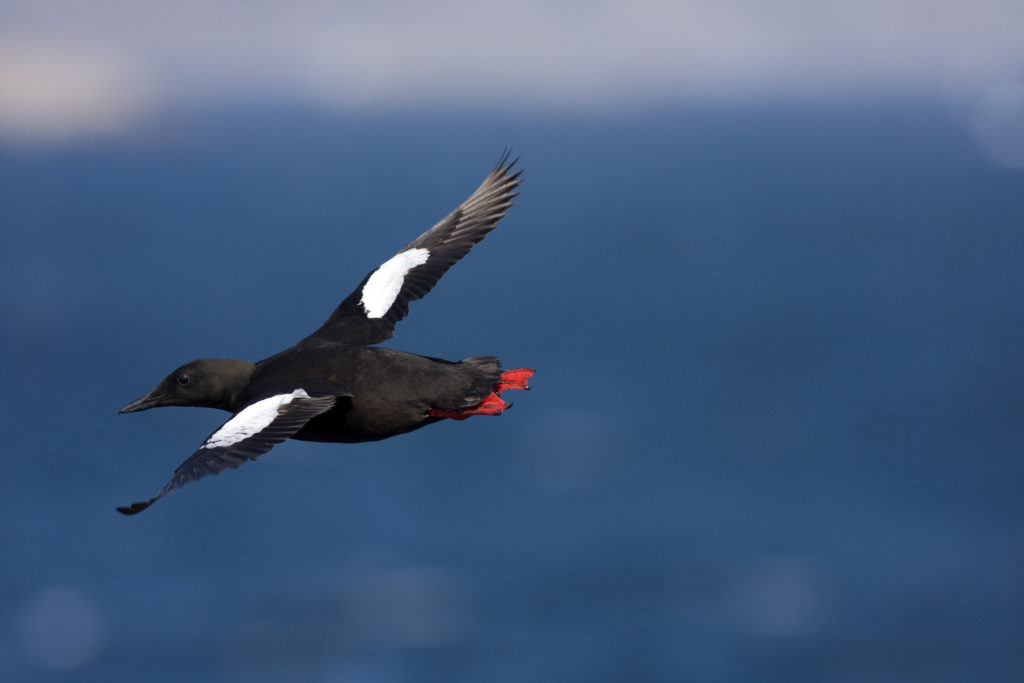 Photo by Håvard Eggen
Photo by Håvard Eggen